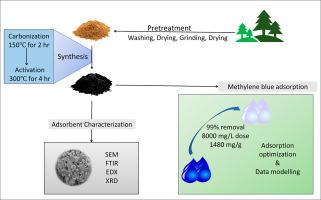松木凋落物活性炭吸附去除亚甲基蓝染料
Q1 Environmental Science
引用次数: 0
摘要
偶氮染料的持久性和毒性对水生生态系统和人类健康构成严重威胁。低成本的吸附剂是大规模污水处理的迫切需要。因此,吸附被认为是最好的方法,并且需要几种低成本的吸附剂。合成了zncl2活化松炭,对其进行了表征(SEM/FTIR/EDX/XRD),并在不同的参数(剂量、pH、浓度)下进行了测试。在最佳条件下,亚甲基蓝的去除率为99.90±0.02%,吸附量为1440 mg/g。拟二级反应模型的R2最高,可达0.9997。亚甲蓝在乙醇中的回收率为98.82±0.14%。研究结果表明,经过3次循环,可去除97.30±0.27%的亚甲基蓝染料。该研究为在工业和家庭装置中合成低成本、高效的水净化吸附剂提供了技术见解。本文章由计算机程序翻译,如有差异,请以英文原文为准。

Adsorptive removal of methylene blue dye using pine litter-derived activated charcoal
Azo dyes pose severe threats to aquatic ecosystems and human health due to their persistence and toxicity. Low-cost adsorbents are urgently needed for scalable wastewater treatment. Therefore, adsorption is considered the best method, and several types of low-cost adsorbents are in demand. ZnCl2-activated pine charcoal was synthesized, characterized (SEM/FTIR/EDX/XRD), and tested under varied parameters (dose, pH, concentration). At optimum conditions, 99.90 ± 0.02 % removal of methylene blue with very high adsorption capacity was observed, i.e., 1440 mg/g. The pseudo-second-order reaction model provided the highest R2 value of up to 0.9997. The recovery of 98.82 ± 0.14 % methylene blue in ethanol was observed. The study concluded that up to 3 cycles, 97.30 ± 0.27 % methylene blue dye can be removed. The study provides technical insights for synthesizing low-cost, highly efficient adsorbents in water purification in industrial and domestic setups.
求助全文
通过发布文献求助,成功后即可免费获取论文全文。
去求助
来源期刊

Bioresource Technology Reports
Environmental Science-Environmental Engineering
CiteScore
7.20
自引率
0.00%
发文量
390
审稿时长
28 days
 求助内容:
求助内容: 应助结果提醒方式:
应助结果提醒方式:


